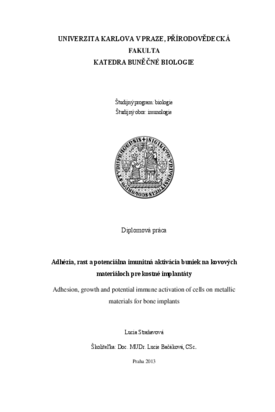Adhézia, rast a potenciálna imunitná aktivácia buniek na kovových materiáloch pre kostné implantáty.
Adhesion, growth and potential immune activation of cells on metallic materials for bone implants.
Adheze, růst a potenciálníimunitní aktivace buněk na kovových materiálech pro kostní implamplantáty.
diplomová práce (OBHÁJENO)

Zobrazit/
Trvalý odkaz
http://hdl.handle.net/20.500.11956/54373Identifikátory
SIS: 119877
Kolekce
- Kvalifikační práce [19114]
Autor
Vedoucí práce
Oponent práce
Filová, Elena
Fakulta / součást
Přírodovědecká fakulta
Obor
Imunologie
Katedra / ústav / klinika
Katedra buněčné biologie
Datum obhajoby
18. 9. 2013
Nakladatel
Univerzita Karlova, Přírodovědecká fakultaJazyk
Slovenština
Známka
Dobře
Klíčová slova (česky)
Adhézia, bunka, osteogénna diferenciácia, BMP-7, osteoblasty, MG- 63, Saos-2Klíčová slova (anglicky)
Adhézia, bunka, osteogénna diferenciácia, BMP-7, osteoblasty, MG- 63, Saos-2V súčasnej ortopédii a traumatológii pohybového aparátu ako aj v stomatológii sa neustále zvyšuje počet operácií, pri ktorých sú používané kovové implantáty. Problematika riešenia kostných defektov je rozsiahla oblasť, kde sú extrémne dôležité povrchové vlastnosti použitých implantátov. Kostné defekty vznikajú často pri otvorených zlomeninách, po radikálnych onkologických operáciách a pri prolongáciách končatín, ktoré sú veľmi časté v detskej ortopédii. Pri liečbe týchto stavov je výhodné, aby bol povrch používaných materiálov atraktívny pre kostné bunky a podporoval novotvorbu kostí. V endoprotetike je veľmi žiaduce, aby došlo k čo najpevnejšiemu spojeniu medzi povrchom implantátu a kosťou. Pri operácii je správnym usadením implantátu dosiahnutá primárna stabilita, ktorá je určená hlavne tvarom implantátu a kvalitou opracovania kosti. Táto stabilita trvá len dočasne, udáva sa doba 3 mesiacov. Po uplynutí tejto doby nastáva sekundárna stabilita, ktorá je daná vrastaním kosti do povrchovej štruktúry implantátu. Osteogénna diferenciácia osteoblastov a mineralizácia extracelulárnej matrix (ECM) môže byť podporená prítomnosťou kostných morfogenetických proteínov (BMP), hlavne BMP-7. Tieto látky cez špecifické povrchové receptory navodzujú maturáciu osteoblastov. Po implantácii môže dôjsť k odmietnutiu...
The contemporary orthopaedics and traumatology of the musculoskeletal system and stomatology have been witnessing a substantial increase in the number of surgeries using metallic implants. The issue of reconstruction of bone defects covers a large area of study, where the surface properties of the implants are extremely important. Bone defects often occur as a result of open fractures, radical cancer treatment or limb lengthening, which is very common in paediatric orthopaedics. In the treatment of these conditions, the surface of the applied materials should provide a favorable environment for bone cells and support bone formation. In endoprosthetics it is highly desirable to achieve the strongest possible fixation between the implant surface and the bone. During the surgery, primary stability of the implant fixation is ensured by the proper positioning of the implant, based on the appropriate shape of the implant and the quality of bone cut. The initial stability is only temporary, being estimated to last approximately three months. After this period, the secondary stability starts, determined by the bone ingrowth into the implant surface structure. Osteogenic differentiation and extracellular matrix (ECM) mineralization can be enhanced by the presence of bone morphogenetic proteins (BMPs),...
